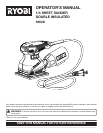
13
OPERATION
ATTACHING SANDER TO VACUUM
See Figure 9.
When sanding for an extended period of time, you can
easily attach the dust collection system of the sander to a
vacuum.
To attach:
Unplug the sander.
Remove dust bag from sander.
Attach vacuum hose to dust exhaust.
NOTE: Vacuum hose fits inside dust exhaust.
Connect sander and vacuum to power supply.
WARNING:
When sander is not connected to vacuum, always install
dust bag back on sander. Failure to do so could cause
sanding dust or foreign objects to be thrown into the face
or eyes which could result in possible serious injury.
Fig. 9
dUST
ExHAUST
vACUUM
HOSE
MAINTENANCE
Electric tools used on fiberglass material, wallboard, spack-
ling compounds, or plaster are subject to accelerated wear
and possible premature failure because the fiberglass chips
and grindings are highly abrasive to bearings, brushes,
commutators, etc. Consequently, we do not recommend
using this product for extended work on these types
of materials. However, if you do work with any of these
materials, it is extremely important to clean the product
using compressed air.
LUBRICATION
All of the bearings in this product are lubricated with a
sufficient amount of high grade lubricant for the life of the
unit under normal operating conditions. Therefore, no further
lubrication is required.
WARNING:
When servicing, use only identical replacement parts.
Use of any other parts may create a hazard or cause
product damage.
WARNING:
Always wear safety goggles or safety glasses with side
shields during power tool operation or when blowing
dust. If operation is dusty, also wear a dust mask.
GENERAL MAINTENANCE
Avoid using solvents when cleaning plastic parts. Most
plastics are susceptible to damage from various types of
commercial solvents and may be damaged by their use. Use
clean cloths to remove dirt, dust, oil, grease, etc.
WARNING:
Do not at any time let brake fluids, gasoline, petroleum-
based products, penetrating oils, etc., come in contact
with plastic parts. Chemicals can damage, weaken, or
destroy plastic which may result in serious personal
injury.
















